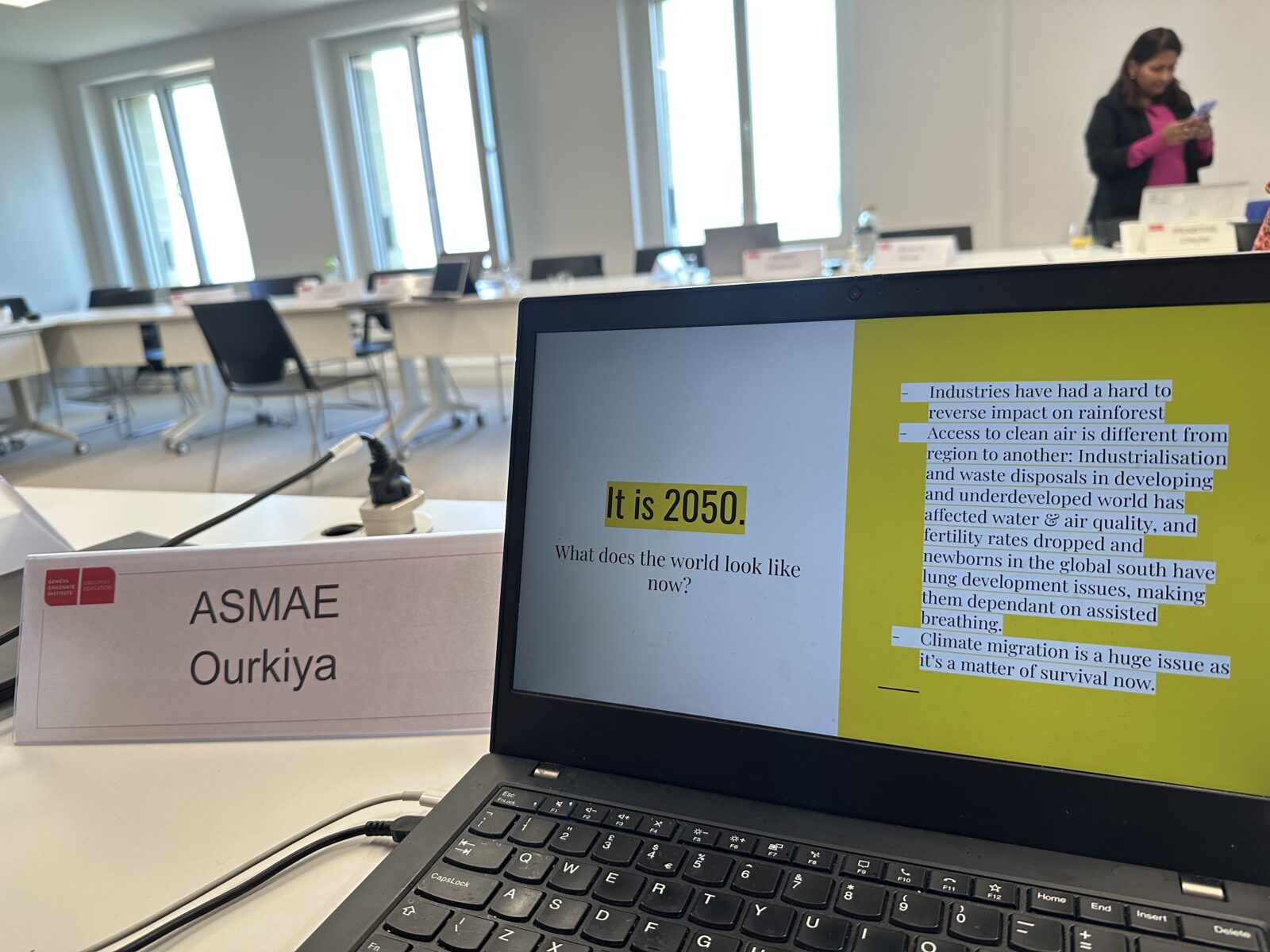
The Geneva Science and Diplomacy Anticipator (GESDA) placed human augmentation on a 5–10 year timeline, identifying it as a key area where technological advancement could soon reshape societies. Their GESDA radar platform tracks over 500 emerging science breakthroughs including enhanced cognition, programmable biology, and climate-resilient bioengineering. The foresight is clear: we are entering an era where augmenting the human body is not a far-off fantasy but a fast-approaching norm. The question is, will it serve justice, or deepen inequality?
I’m writing this after having recently completed an executive course on Strategic Foresight by the Geneva Graduate Institute in Geneva, Switzerland. Throughout the course, we learned how to systematically explore and anticipate different possible futures, so we can make smarter decisions today. Strategic foresighting isn’t about predicting what will happen. It’s about exploring what could happen, challenging our assumptions, and preparing for different possibilities. Unlike forecasting, which deals with trends and probabilities, foresighting is about surfacing (i.e. revealing underlying patterns) and shaping alternative futures, especially in times of deep uncertainty.
We often forget that the future, like the present, is political. It is built by those with the power to imagine, fund, and impose certain versions of it. The challenge in foresight is to recognize these embedded assumptions, many of which are inherited from hegemonic powers, and question: Whose future are we imagining? And whose future are we erasing?
One core lesson from the course was this: the older we get, the more rigid we become about our assumptions. Futures literacy, a concept supported by UNESCO, encourages us to stay flexible, to challenge the dominant narratives, and to build new, more inclusive stories of tomorrow. The methodology is systemic and recognises that no issue exists in isolation. In foresight, everything connects.
So let me take you on a trip to the future: it’s 2050, and our planet is +2°C warmer.
2050: The augmented reality we didn’t ask for
The 1.5°C threshold? We blew past it. With authoritarian government heads adopting a petromasculine approach to withdraw from regional and global climate agreements, and boost industrial growth without environmental considerations, it is no surprise that we were not able to meet the threshold. The past thirty years have seen a cascade of viral pandemics and environmental shocks. There is no World Health Organization anymore. Instead, intergovernmental pharmaceutical alliances dominate global health diplomacy, and powerful countries have gone solo, trusting corporations more than treaties.
Water scarcity is a global emergency, especially in desertified regions. Clean air and water have become a privilege, unevenly distributed across the globe. In postcolonial and resource-exploited regions, industrial waste and extractivist pollution have ravaged fertility rates and newborns struggle with lung development, hooked to assisted breathing machines from birth.
Rainforests? Scarred and shrinking. Industrial impacts have pushed some ecosystems to the brink of collapse. Climate migration is no longer a forecast but a matter of daily survival.
Food? Nutricubes (cubes manufactured by big pharma) have replaced meals in many regions. While some isolated communities still have access to real, nutritious food, most populations rely on factory-pressed cubes of synthetic sustenance. The line between supplement and meal has disappeared, and with it, much of food culture and biodiversity. People barely have any knowledge on farming, seeds, or food production the way it used to be. Some people, who are less privileged than others, have never even tasted a fresh fruit!
The toxic cocktail of ozone, sulfur dioxide, nitrogen oxides, methane smog, carbon monoxide, and PM2.5 particles inflames airways, shrinks brains, and suffocates the human spirit. Every breath is a gamble. And new autoimmune diseases are emerging like wild cards in a broken deck.
Enter human augmentation
In this context, human augmentation has become the difference between life and death. We’re not just talking about cosmetic enhancements or laser eye surgery. We’re talking about bionic limbs, fertility implants, AI-integrated brain chips, climate-resistant skin grafts, and epigenetic DNA mutations to increase heat and pollution tolerance. The body has become a battleground for adaptation.
But here’s the catch: access is limited and kept for the elite.
Governance is fragmented. Nation-states and powerful corporations dominate the rules of the game. A black market for augmentations thrives (I highly recommend watching Years and Years for a visual glimpse into this!) In some countries, enhancements are mandatory (like vaccines). In others, they’re restricted, either for safety concerns, religious reasons, or lack of infrastructure. The corporations call the shots in controlling climate-resistant augmentations and fertility treatments.
In this world, climate change didn’t just reshape the planet, it reshaped our species.
The rise of the augmented elite
As with any technology, augmentation has created winners and losers. A bio-class system emerged, with the augmented elite living in climate-controlled, tech-protected zones, while others battle illness and degradation. The line between enhanced and “natural” has become a flashpoint for social conflict.
Are you aug? – a phrase echoing the old academic gatekeeping question “Are you faculty?” – has become a shorthand for status, access, and survival. In academic spaces, around 30 or 40 years ago, that question used to determine whether someone engages with you seriously. In the world of 2050, Are you aug? decides whether you are heard, helped, given a loan, or hired. It’s a casual query laced with consequence: a marker of bio-privilege. Bio-piracy flourishes. Rogue hackers tinker with genomes. Black market clinics offer risky counter-augments. Corporations patent human genomes for profit. Social segregation deepens. Resistance grows.
The augmented can breathe in the smog and swim in rising seas. The rest choke on air that was once clean for them to breathe.
Looking back from the future: 2025 is the fork in the road
But let’s come back. It’s 2025. We are not there yet.
We still have a chance to build a more just, equitable, and climate-resilient future. That begins with rethinking not just what kind of technologies we want, but who they are for.
We need:
- Robust ethical standards for human augmentation.
- A globally coherent regulatory framework.
- Equitable access to life-saving and life-improving technologies.
- Large-scale climate adaptation strategies rooted in justice.
And just as importantly, we need imagination. We can use foresight to explore alternative futures where humanity doesn’t depend on expensive augmentation to survive, but instead transforms its economic, environmental, political, and social systems to be more sustainable, resilient, and inclusive.
Strategic foresight in action: Here’s how I did it
Through methodologies like the Futures Cone, the Future Wheel, the Foresight Diamond, and Causal Layered Analysis (CLA), we can dissect assumptions, identify critical uncertainties, and map potential trajectories. Organizations like NATO, UNEP, and GESDA already employ such tools to align present-day policy with long-term challenges.
During an exercise in the course, my group and I scoped a scenario that resulted in writing this blog: How will human augmentation affect climate-induced health issues by 2050?
- Focal issue: Human enhancement as climate adaptation
- Time horizon: 25 years
- Stakeholders: Pharma, biotech, governments, civil society, academia, regulatory bodies
- Driving forces: Resource scarcity, self-preservation, gerosciences, air and water degradation
- Critical uncertainties: Who gets access? Who is left out?
I also used the PESTLE analysis to expose multiple layers:
- Political resistance vs. authoritarian control
- Economic monopolies over augmentation tech
- Social segregation and augmented identity debates
- Technological acceleration and regulation lag
- Legal grey zones and global inconsistencies
- Environmental degradation necessitating biotech fixes
The augmented future isn’t inevitable: It’s a choice
We often treat the future as a destination. But it’s not: it’s a battleground, a construction site, a contested space. And we are not just passengers; we’re the architects, engineers, and storytellers.
If we reach 2050 without taking climate action seriously, the world won’t just be hotter, it will be harsher, more unequal, and more unstable where peace and security are words from the past, lingering among the very few privileged groups. We risk locking in a future where survival hinges on access to expensive enhancements and artificial resilience, while authoritarian leaders profit from fear, control, and techno-nationalism.
The next COPs must go beyond carbon counting. They must confront extractivism, tech monopolies, and the biopolitics of survival. Climate justice must expand to include health justice, tech governance, and bio-accessibility, especially for communities historically looted, polluted, and excluded.
Strategic foresight reminds us that there is more than one path forward. The work of 2025 is not to predict 2050. It is to prevent the worst, prepare for the unpredictable, and propose futures where technology serves people, not profits.



